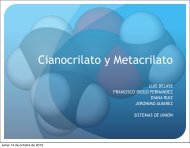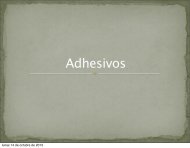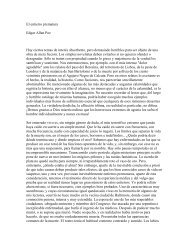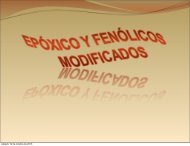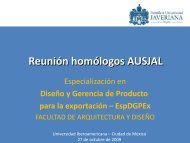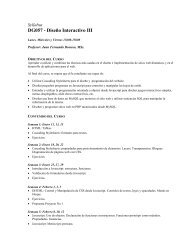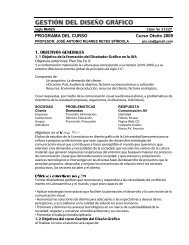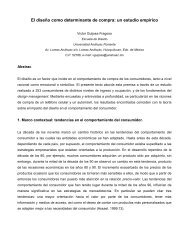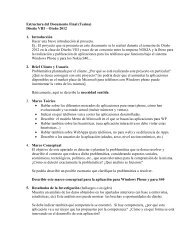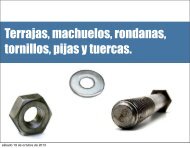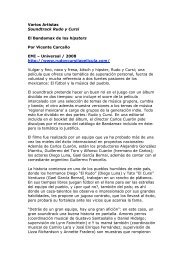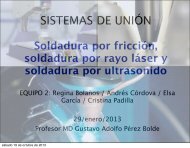Diseño sin Fronterasintellectual basis for faculty performance and not onlyteacher conduct. The author affirms that if one intends totake this i<strong>de</strong>a seriously, it is indispensable to revise teachingas well as the content of teacher training programs. Theseprograms can no longer restrict their activities to didacticsand to supervision alone, but also on the formation ofteacher capacity to reflect on teaching and to teach specificsubjects, as well as his capacity to base his actions onpremises that resist complete analysis from the professionalcommunity.The adoption of this perspective gains strength fromKramer’s (1997) statement, which consi<strong>de</strong>rs a new proposalfor education as a bet.:A new proposal for education; a new curriculum is aninvitation, a challenge, a bet. A bet because, as part of agiven public policy, it contains a political project for societyand a concept of citizenship, of education and of culture.Therefore, one cannot bring ready-ma<strong>de</strong> answers just tobe implemented if one aims at contributing towards theconstruction of a <strong>de</strong>mocratic society where social justiceis in<strong>de</strong>ed an equally distributed asset to all. A pedagogicalproposal always expresses the values of which it is comprisedand it needs to be closely tied to the reality on whichit focuses, explaining its objectives of critically thinkingof this reality, and confronting it most acute problems.A pedagogical proposal must be constructed with theactual participation of all subjects – children and adults,stu<strong>de</strong>nts, teachers and non-faculty professionals, familiesand the population in general – taking into consi<strong>de</strong>rationtheir needs, specificities and reality. This also points to theimpossibility of a single proposal, since reality is multipleand contradictory. (Kramer, 1997, p. 21).Closely echoing the i<strong>de</strong>as of Shulman and Kramer, weresort to Efland; et al. (2003) when they affirm that the paththat awaits us is uncertain and the ante high. According tothese authors, if we could successfully apply a post-mo<strong>de</strong>rnfocus on artistic education and we could inclu<strong>de</strong> Designhere, general knowledge of cultural diversity would fill thevacuum left behind mere isolated data presented in theteacher formation process and <strong>de</strong>signers. An educationconstructed from multiple perspectives foments criticalthought, acceptance and tolerance of difference. It also provi<strong>de</strong>san exercise in <strong>de</strong>mocratic action and a reevaluationof our ecological, educational and social responsibilities, aswe have already pointed out.Final consi<strong>de</strong>rationsThroughout the elaboration of this research study,through an interdisciplinary dialogue between Designand Education, we sought to i<strong>de</strong>ntify how Design’s activitycould participate in teaching-learning processes and in theconfiguration of pedagogical materials, with the objectiveof enhancing the knowledge acquisition process throughthe configuration of artifacts, environments and analogand digital systems.The Design in Situations of Teaching-Learning line ofresearch served as a basis to expand knowledge of therelationship between the two main areas involved. It was<strong>de</strong>fined as an area preferably inserted in the aca<strong>de</strong>micfield and that agglutinates works where there is <strong>de</strong>signerparticipation in projects geared towards Education atany level - Nursery, Elementary, High School, Higher andAdvanced - as well as for studies and research related tothe teaching of Design in the extra-university, technical,extension, un<strong>de</strong>rgraduate and graduate ambits. Its basicprinciple is to enhance the knowledge construction process.In this perspective, each Design solution representsthe search for equilibrium between interests and needsof the teacher and stu<strong>de</strong>nt, as well as of educationalinstitutions.Through this research, we sought to create subsidies forplanning educational materials from a multiple perspective,which observes the educational specificities and itsdialogue as well as the transit with neighboring reality,aimed at the creation of more productive and interactiveteaching-learning processes.The option of using an artifact <strong>de</strong>veloped in light of Designas the object of study for this research, registering anddiscussing its configuration process and the experiencethat took place in its <strong>de</strong>velopment process was <strong>de</strong>cisive forun<strong>de</strong>rstanding the diverse issues involved in a Design inSituations of Teaching-Learning project.We also verify that the practice of Design in Situations ofTeaching-Learning enables <strong>de</strong>signers to <strong>de</strong>al with complexproblems. In this particular point, the formation of interdisciplinaryteams is indispensable, since they provi<strong>de</strong> forthe creation of efficient educational artifacts, promotingand sustaining educational relations, providing dialoguebetween the teacher and stu<strong>de</strong>nt in the teaching-learningprocess.The more in-<strong>de</strong>pth theoretical study conducted onteaching-learning issues helped us, gui<strong>de</strong>d by Shulman’si<strong>de</strong>as, to un<strong>de</strong>rstand that to obtain results in the teachingprocess it is necessary and obligatory for it to be conceivedas an activity that implies joint work between teachers andstu<strong>de</strong>nts. This work implies exercising thought as well asaction by all players.The proposal for a pedagogical reasoning and actionmo<strong>de</strong>l to analyze projects within the scope of the Designin Situations of Teaching-Learning line of research wasconceived using the Multi-Tracks Project as a case study.41
MX Design Conference 2011This led to the conclusion that the application of Designmethods and techniques in objects directed towards teaching<strong>de</strong>af children to read and write, for example, may notonly help make this task more productive and pleasant, butalso contribute towards <strong>de</strong>limiting a multidisciplinary fieldcomprised of Design, Education, Art, Psycho-Pedagogy,Information Technology, among others.From this research, it was possible to create an outline fora Design in Situations of Teaching-Learning methodologycomprised of cyclical actions where the steps ofthe methodology, that is, information, experience, data,evaluations, <strong>de</strong>cisions, conclusions, etc. are in interactivemovement, being covered for un<strong>de</strong>rstanding, fitness and<strong>de</strong>velopment of the project one intends to carry out.ReferencesBONFIM, Gustavo. A. “Algumas consi<strong>de</strong>rações sobre teoriae pedagogia do <strong>de</strong>sign”. Rio <strong>de</strong> Janeiro: Estudos emDesign. V. 2, n° 2, 1999.KRAMER, Sônia. “Propostas pedagógicas ou curriculares:Subsídios para uma leitura crítica”. Educação &Socieda<strong>de</strong>, ano XVIII, nº 60, <strong>de</strong>zembro, 1997.PORTUGAL, Cristina. Design em Situações <strong>de</strong> Ensinoaprendizagem.Estudos em Design v18 n’.2, Rio <strong>de</strong>Janeiro, 2010.SHULMAN, Lee S. “Paradigmas y Programas <strong>de</strong>Investigación en el Estudio <strong>de</strong> la Enseñanza: UnaPerspectiva Contemporánea”, en WITTROCK, Merlin C.(ed.): La Investigación <strong>de</strong> la Enseñanza, I. Enfoques, Teoríasy Métodos, Barcelona: Paidós, 1986.Conocimiento y enseñanza: fundamentos <strong>de</strong> la nueva reforma.Disponível em: http://www.ugr.es/local/recfpro/Rev92ART1.pdf. Acesso 20 <strong>de</strong> Set. <strong>de</strong> 2008.SOMMERMAN, Américo. Inter e Transdiciplinarida<strong>de</strong>?: dafragmentação interdisciplinar ao no diálogo entre ossaberes. São Paulo: Paulos. 2006.BONSIEPE, Guisepe. Design do material ao digital.Florianópolis: FIESC/IEL, 1997.BRUNER, Jerome. Actos <strong>de</strong> Significado. Más allá <strong>de</strong> laRevolución Cognitiva, Madrid: Ed. Alianza, 2006.CAPRA, Fritjof. Pertencendo ao universo: explorações nasfronteiras da ciência e da espiritualida<strong>de</strong>. São Paulo:Cultrix, 1994.COUTO, Rita M. S. “Desenvolvimento <strong>de</strong> ilustrações <strong>de</strong>movimentos da Língua <strong>de</strong> Sinais Brasileira - LIBRAS”. In:4º Congresso Internacional <strong>de</strong> Design da Informação &3º InfoDesign Brasil | Congresso Brasileiro <strong>de</strong> Design daInformação, Rio <strong>de</strong> Janeiro: PUC-Rio, 2009.EFLAND, Arthur D.; FREEDMAN, Kerry e STUHR, Patrícia.Educación y el Arte Posmo<strong>de</strong>rno. Barcelona: Paidos,2003.FONTOURA, Antonio M. EdaDe – Educação <strong>de</strong> crianças ejovens através do <strong>de</strong>sign. Florianópolis, 2002. 337p. Tese(Doutorado em Engenharia da Produção) – Programa<strong>de</strong> Pós-Graduação em Engenharia da Produção, SantaCatarina: UFSC, 2002.FRASCARA, Jorge. Diseño gráfico para la gente. BuenosAires: Infinito, 1997.FREEDMAN, Kerry. Emseñar La Cultura Visual. Barcelona:Octaedro, 2003.42
- Page 2 and 3: MX Design Conference 2011Diseño si
- Page 4 and 5: ÍndiceCapeltic, una experiencia in
- Page 6 and 7: Diseño sin FronterasCapeltic, una
- Page 8 and 9: Diseño sin FronterasInvestigacione
- Page 10 and 11: Diseño sin Fronteras2) Una Empresa
- Page 12 and 13: Diseño sin Fronteras Se trabaja co
- Page 14 and 15: Diseño sin FronterasAhora bien, al
- Page 16 and 17: Diseño sin Fronteraslas personas a
- Page 18 and 19: Diseño sin FronterasDe esta manera
- Page 20 and 21: Diseño sin FronterasTercera fase:
- Page 22 and 23: Diseño sin FronterasDesign & Cultu
- Page 24 and 25: Diseño sin Fronteras Ideological p
- Page 26 and 27: Diseño sin Fronterasmain objective
- Page 28 and 29: Diseño sin FronterasHofstede´s cu
- Page 30 and 31: Diseño sin FronterasJORDAN, P., De
- Page 32 and 33: Diseño sin Fronterasour personalit
- Page 34 and 35: Diseño sin FronterasThe Color in D
- Page 36 and 37: Diseño sin FronterasDesign in Teac
- Page 38 and 39: Diseño sin FronterasWe introduce t
- Page 42 and 43: Diseño sin FronterasDesign Laborat
- Page 44 and 45: Diseño sin Fronterassustainable de
- Page 46 and 47: Diseño sin Fronteras4) Web design
- Page 48 and 49: Diseño sin Fronterasdemonstrating
- Page 50 and 51: Diseño sin Fronteraswith an encomp
- Page 52 and 53: Diseño sin FronterasDesign, Cultur
- Page 54 and 55: Diseño sin Fronterasb. Clothing: c
- Page 56 and 57: Diseño sin Fronterasappropriate fo
- Page 58 and 59: Diseño sin FronterasReferencesAPPA
- Page 60 and 61: Diseño sin Fronterasconocimiento 3
- Page 62 and 63: Diseño sin FronterasEntre los resu
- Page 64 and 65: Diseño sin FronterasOncología. Di
- Page 66 and 67: Diseño sin FronterasDistributed Co
- Page 68 and 69: Diseño sin Fronteras3 COLS: Web-ba
- Page 70 and 71: Diseño sin Fronterasoutcome, ‘pr
- Page 72 and 73: Diseño sin FronterasTable 1. List
- Page 74 and 75: Diseño sin Fronterasin which they
- Page 76 and 77: Diseño sin FronterasWithout attent
- Page 78 and 79: Diseño sin Fronterasexample, the d
- Page 80 and 81: Diseño sin Fronteras(fig.1). Despu
- Page 82 and 83: Diseño sin FronterasEl diseño est
- Page 84 and 85: Diseño sin Fronteras1. Ser un medi
- Page 86 and 87: Diseño sin FronterasEl diseño est
- Page 88 and 89: Diseño sin Fronterascionados con l
- Page 90 and 91:
Diseño sin FronterasR&.)''$--)'"&+
- Page 92 and 93:
Diseño sin FronterasSegún la inve
- Page 94 and 95:
Diseño sin Fronterasde educación
- Page 96 and 97:
Diseño sin FronterasEnfoque y meto
- Page 98 and 99:
Diseño sin FronterasLos esquemas p
- Page 100 and 101:
Diseño sin FronterasWireframes - S
- Page 102 and 103:
Diseño sin FronterasEstos efectos
- Page 104 and 105:
Diseño sin Fronterasa special ques
- Page 106 and 107:
Diseño sin Fronteras“cool” tre
- Page 108 and 109:
Diseño sin Fronterasy por esta raz
- Page 110 and 111:
Diseño sin Fronterasindustrial. Va
- Page 112 and 113:
Diseño sin Fronterasmejor desempe
- Page 114 and 115:
Diseño sin Fronterasganancia econ
- Page 116 and 117:
Diseño sin Fronterasproposing solu
- Page 118 and 119:
Diseño sin Fronteras3. The first r
- Page 120 and 121:
Diseño sin FronterasInterdisciplin
- Page 122 and 123:
Diseño sin Fronterasu opor tunidad
- Page 124 and 125:
Diseño sin Fronterasla formulació
- Page 126 and 127:
Diseño sin FronterasInterdisciplin
- Page 128 and 129:
Diseño sin Fronterasreal de una or
- Page 130 and 131:
Diseño sin FronterasConclusionesHa
- Page 132 and 133:
Diseño sin FronterasEn numerosas o
- Page 134 and 135:
Diseño sin Fronterashace reflexion
- Page 136 and 137:
Diseño sin Fronterasocasiones no e
- Page 138 and 139:
Diseño sin Fronterascondición de
- Page 140 and 141:
Diseño sin FronterasLa psicología
- Page 142 and 143:
Diseño sin FronterasReferencias bi
- Page 144 and 145:
Diseño sin FronterasMetodologíaLa
- Page 146 and 147:
Diseño sin Fronterasvisión se com
- Page 148 and 149:
Diseño sin FronterasLa mediación
- Page 150 and 151:
Diseño sin Fronteraspermiten el ac
- Page 152 and 153:
Diseño sin Fronterassolo el 5% de
- Page 154 and 155:
Diseño sin FronterasFrías, J. (20
- Page 156 and 157:
Diseño sin FronterasLa noción de
- Page 158 and 159:
Diseño sin FronterasMirada de Muje
- Page 160 and 161:
Diseño sin Fronterasidentidades, d
- Page 162 and 163:
Diseño sin FronterasIntroducciónE
- Page 164 and 165:
Diseño sin Fronteraso revelan a tr
- Page 166 and 167:
Diseño sin FronterasCon respecto t
- Page 168 and 169:
Diseño sin Fronterasprofesional y
- Page 170 and 171:
Diseño sin Fronteras¿Qué es wiri
- Page 172 and 173:
Diseño sin FronterasWiring es una
- Page 174 and 175:
Diseño sin FronterasSources of inn
- Page 176 and 177:
Diseño sin FronterasFeatureDescrip
- Page 178 and 179:
Diseño sin FronterasEncoding relev
- Page 180 and 181:
Diseño sin FronterasThe new design
- Page 182 and 183:
Diseño sin Fronteraslearn by doing
- Page 184 and 185:
Diseño sin FronterasThe Open(d) Fr
- Page 186 and 187:
Diseño sin Fronterasdisseminate th
- Page 188 and 189:
Diseño sin Fronterascontrib- ute d
- Page 190 and 191:
Diseño sin FronterasThe same digit
- Page 192 and 193:
Diseño sin Fronterasque desde todo
- Page 194 and 195:
Diseño sin FronterasFigura 4 refer



